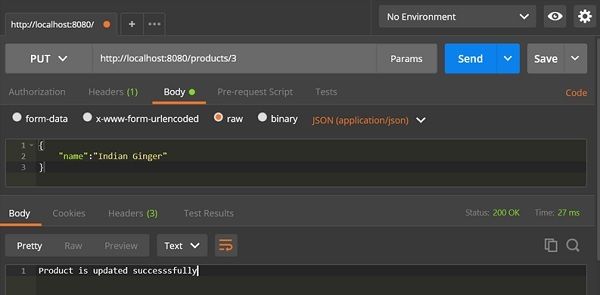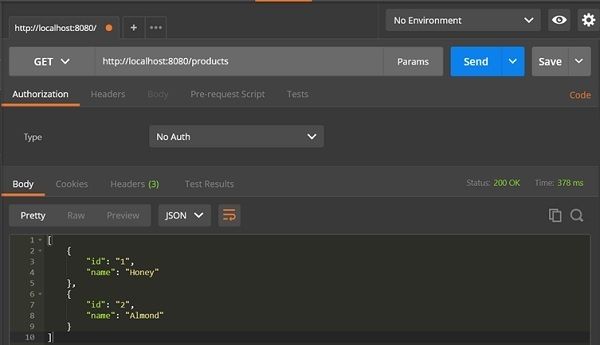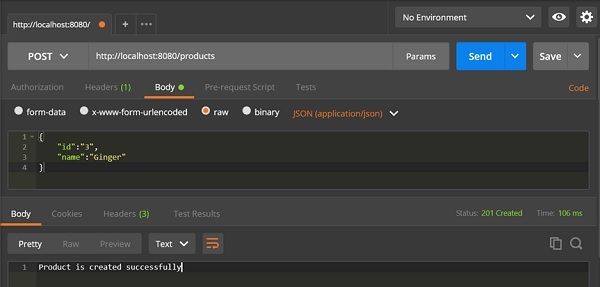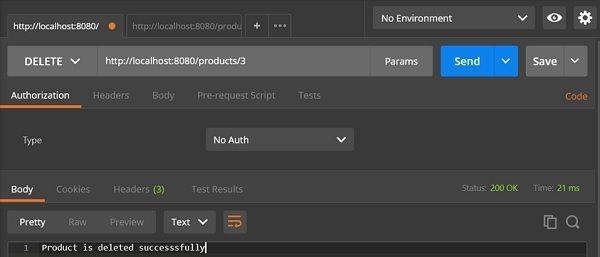【注】本文译自: https://www.tutorialspoint.com/spring_boot/spring_boot_building_restful_web_services.htm
![]()
Spring Boot 提供了构建企业应用中 RESTful Web 服务的极佳支持。本文为你详解如何使用 Spring Boot 构建 RESTful web 服务。
注意:要构建 RESTful Web 服务,我们需要在构建配置文件中加上 Spring Boot Starter Web 依赖。
对于 Maven 用户,使用以下的代码在 pom.xml 文件中加入依赖:
对于 Gradle 用户,使用以下的代码在 build.gradle 文件中加入依赖:
compile('org.springframework.boot:spring-boot-starter-web')
完整的构建配置文件 Maven build – pom.xml 如下:
xmlns:xsi = "http://www.w3.org/2001/XMLSchema-instance"
xsi:schemaLocation = "http://maven.apache.org/POM/4.0.0
http://maven.apache.org/xsd/maven-4.0.0.xsd">
完整的构建配置文件 Gradle Build – build.gradle 如下:
bbuildscript {
ext {
springBootVersion = '1.5.8.RELEASE'
}
repositories {
mavenCentral()
}
dependencies {
classpath("org.springframework.boot:spring-boot-gradle-plugin:${springBootVersion}")
}
}
apply plugin: 'java'
apply plugin: 'eclipse'
apply plugin: 'org.springframework.boot'
group = 'com.tutorialspoint'
version = '0.0.1-SNAPSHOT'
sourceCompatibility = 1.8
repositories {
mavenCentral()
}
dependencies {
compile('org.springframework.boot:spring-boot-starter-web')
testCompile('org.springframework.boot:spring-boot-starter-test')
}
在继续构建 RESTful web 服务前,建议你先要熟悉下面的注解:
Rest Controller
@RestController 注解用于定义 RESTful web 服务。它提供 JSON、XML 和自定义响应。语法如下所示:
@RestController
public class ProductServiceController {
}
Request Mapping
@RequestMapping 注解用于定义请求 URI 以访问 REST 端点。我们可以定义 Request 方法来消费 produce 对象。默认的请求方法是 GET:
@RequestMapping(value = "/products")
public ResponseEntity
Request Body
@RequestBody 注解用于定义请求体内容类型。
public ResponseEntity
}
Path Variable
@PathVariable 注解被用于定义自定义或动态的请求 URI,Path variable 被放在请求 URI 中的大括号内,如下所示:
public ResponseEntity
}
Request Parameter
@RequestParam 注解被用于从请求 URL 中读取请求参数。缺少情况下这是一个必需的参数,也可以为请求参数设置默认值,如下所示:
public ResponseEntity
@RequestParam(value = "name", required = false, defaultValue = "honey") String name) {
}
GET API
默认的 HTTP 请求方法是 GET。这个方法不需要任何请求体。你可以通过发送请求参数和路径变量来定义自定义或动态 URL。
下面的示例代码定义了 HTTP GET 请求方法。在这个例子吧,我们使用 HashMap 来在存储 Product。注意我们使用了 POJO 类来存储产品。
在这里,请求 URI 是 /products,它会从 HashMap 仓储中返回产品列表。下面的控制器类文件包含了 GET 方法的 REST 端点:
package com.tutorialspoint.demo.controller;
import java.util.HashMap;
import java.util.Map;
import org.springframework.http.HttpStatus;
import org.springframework.http.ResponseEntity;
import org.springframework.web.bind.annotation.RequestMapping;
import org.springframework.web.bind.annotation.RestController;
import com.tutorialspoint.demo.model.Product;
@RestController
public class ProductServiceController {
private static Map
static {
Product honey = new Product();
honey.setId("1");
honey.setName("Honey");
productRepo.put(honey.getId(), honey);
Product almond = new Product();
almond.setId("2");
almond.setName("Almond");
productRepo.put(almond.getId(), almond);
}
@RequestMapping(value = "/products")
public ResponseEntity
return new ResponseEntity<>(productRepo.values(), HttpStatus.OK);
}
}
POST API
HTTP POST 请求用于创建资源。这个方法包含请求体。我们可以通过发送请求参数和路径变量来定义自定义或动态 URL。
下面的示例代码定义了 HTTP POST 请求方法。在这个例子中,我们使用 HashMap 来存储 Product,这里产品是一个 POJO 类。
这里,请求 URI 是 /products,在产品被存入 HashMap 仓储后,它会返回字符串。
package com.tutorialspoint.demo.controller;
import java.util.HashMap;
import java.util.Map;
import org.springframework.http.HttpStatus;
import org.springframework.http.ResponseEntity;
import org.springframework.web.bind.annotation.RequestBody;
import org.springframework.web.bind.annotation.RequestMapping;
import org.springframework.web.bind.annotation.RequestMethod;
import org.springframework.web.bind.annotation.RestController;
import com.tutorialspoint.demo.model.Product;
@RestController
public class ProductServiceController {
private static Map
@RequestMapping(value = "/products", method = RequestMethod.POST)
public ResponseEntity
productRepo.put(product.getId(), product);
return new ResponseEntity<>("Product is created successfully", HttpStatus.CREATED);
}
}
PUT API
HTTP PUT 请求用于更新已有的资源。这个方法包含请求体。我们可以通过发送请求参数和路径变量来定义自定义或动态 URL。
下面的例子展示了如何定义 HTTP PUT 请求方法。在这个例子中,我们使用 HashMap 更新现存的产品。此处,产品是一个 POJO 类。
这里,请求 URI 是 /products/{id},在产品被存入 HashMap 仓储后,它会返回字符串。注意我们使用路径变量 {id} 定义需要更新的产品 ID:
package com.tutorialspoint.demo.controller;
import java.util.HashMap;
import java.util.Map;
import org.springframework.http.HttpStatus;
import org.springframework.http.ResponseEntity;
import org.springframework.web.bind.annotation.PathVariable;
import org.springframework.web.bind.annotation.RequestBody;
import org.springframework.web.bind.annotation.RequestMapping;
import org.springframework.web.bind.annotation.RequestMethod;
import org.springframework.web.bind.annotation.RestController;
import com.tutorialspoint.demo.model.Product;
@RestController
public class ProductServiceController {
private static Map
@RequestMapping(value = "/products/{id}", method = RequestMethod.PUT)
public ResponseEntity
productRepo.remove(id);
product.setId(id);
productRepo.put(id, product);
return new ResponseEntity<>("Product is updated successsfully", HttpStatus.OK);
}
}
DELETE API
HTTP Delete 请求用于删除存在的资源。这个方法不包含任何请求体。我们可以通过发送请求参数和路径变量来定义自定义或动态 URL。
下面的例子展示如何定义 HTTP DELETE 请求方法。这个例子中,我们使用 HashMap 来移除现存的产品,用 POJO 来表示。
请求 URI 是 /products/{id} 在产品被从 HashMap 仓储中删除后,它会返回字符串。 我们使用路径变量 {id} 来定义要被删除的产品 ID。
package com.tutorialspoint.demo.controller;
import java.util.HashMap;
import java.util.Map;
import org.springframework.http.HttpStatus;
import org.springframework.http.ResponseEntity;
import org.springframework.web.bind.annotation.PathVariable;
import org.springframework.web.bind.annotation.RequestBody;
import org.springframework.web.bind.annotation.RequestMapping;
import org.springframework.web.bind.annotation.RequestMethod;
import org.springframework.web.bind.annotation.RestController;
import com.tutorialspoint.demo.model.Product;
@RestController
public class ProductServiceController {
private static Map
@RequestMapping(value = "/products/{id}", method = RequestMethod.DELETE)
public ResponseEntity
productRepo.remove(id);
return new ResponseEntity<>("Product is deleted successsfully", HttpStatus.OK);
}
}
下面给出完整的源代码:
Spring Boot 主应用类 – DemoApplication.java
package com.tutorialspoint.demo;
import org.springframework.boot.SpringApplication;
import org.springframework.boot.autoconfigure.SpringBootApplication;
@SpringBootApplication
public class DemoApplication {
public static void main(String[] args) {
SpringApplication.run(DemoApplication.class, args);
}
}
POJO 类 – Product.java
package com.tutorialspoint.demo.model;
public class Product {
private String id;
private String name;
public String getId() {
return id;
}
public void setId(String id) {
this.id = id;
}
public String getName() {
return name;
}
public void setName(String name) {
this.name = name;
}
}
Rest Controller 类 – ProductServiceController.java
package com.tutorialspoint.demo.controller;
import java.util.HashMap;
import java.util.Map;
import org.springframework.http.HttpStatus;
import org.springframework.http.ResponseEntity;
import org.springframework.web.bind.annotation.PathVariable;
import org.springframework.web.bind.annotation.RequestBody;
import org.springframework.web.bind.annotation.RequestMapping;
import org.springframework.web.bind.annotation.RequestMethod;
import org.springframework.web.bind.annotation.RestController;
import com.tutorialspoint.demo.model.Product;
@RestController
public class ProductServiceController {
private static Map
static {
Product honey = new Product();
honey.setId("1");
honey.setName("Honey");
productRepo.put(honey.getId(), honey);
Product almond = new Product();
almond.setId("2");
almond.setName("Almond");
productRepo.put(almond.getId(), almond);
}
@RequestMapping(value = "/products/{id}", method = RequestMethod.DELETE)
public ResponseEntity
productRepo.remove(id);
return new ResponseEntity<>("Product is deleted successsfully", HttpStatus.OK);
}
@RequestMapping(value = "/products/{id}", method = RequestMethod.PUT)
public ResponseEntity
productRepo.remove(id);
product.setId(id);
productRepo.put(id, product);
return new ResponseEntity<>("Product is updated successsfully", HttpStatus.OK);
}
@RequestMapping(value = "/products", method = RequestMethod.POST)
public ResponseEntity
productRepo.put(product.getId(), product);
return new ResponseEntity<>("Product is created successfully", HttpStatus.CREATED);
}
@RequestMapping(value = "/products")
public ResponseEntity
return new ResponseEntity<>(productRepo.values(), HttpStatus.OK);
}
}
你可以创建可执行的 JAR 文件,使用以下的 Maven 或 Gradle 命令来运行 spring boot 应用:
Maven命令如下:
mvn clean install
“构建成功“后,可以在 target 文件夹下发现 JAR 文件。
Gradle命令如下:
gradle clean build
“构建成功“后,可以在 build/libs 文件夹下发现 JAR 文件。
可以使用以下命令来运行 JAR 文件:
java –jar
以 Tomcat 端口号 8080 启动应用,如下所示:
![]()
在 POSTMAN 应用中点击下面的 URL 可以看到相应的输出:
GET API URL 为: http://localhost:8080/products
POST API URL 为: http://localhost:8080/products
PUT API URL 为: http://localhost:8080/products/3

DELETE API URL 为: http://localhost:8080/products/3


